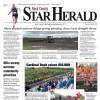By Lori EhdeThis year is shaping up to be one of the biggest growth years ever in the history of feedlots in Rock County.According to Doug Bos, Land Management Assistant Director, there may be as many as 25 new feedlot projects in Rock County this year.Last year, by comparison, there were four major constructions and expansions and three modifications (to manure pits and filter strips, for example)."It’s huge," Bos said of this year’s activity. Most of this year’s plans involve hogs, but one third is for cattle."It’s probably the biggest expansion in cattle we’ve seen for quite a few years. … probably 10 years," Bos said.Of the 25 feedlot projects on deck for this year, at least five are for construction on new sites. Others involve new construction on existing sites, and others involve expansions or modifications to existing structures.Why the feedlot flurry?Bos pointed to both livestock and land markets as reasons for the jump in feedlot permits this year.For one thing, livestock prices – both cattle and hogs – are strong.Cattle prices are hovering at more than $1 per pound for finished cattle and as much $1.50 per pound per feeder cattle. Typically, 80 cents per pound is considered a good price.Hog prices are at nearly 58 cents per pound where typically they’re around 40 cents per pound.A reason for high livestock prices is that U.S. borders are still closed to foreign beef since the Mad Cow scare. This drives demand for all local meat, including beef and pork.Bos said contract feeding is becoming popular among producers putting up confinements. "Producers are paid a set amount to feed the cattle or hogs out," Bos said. "We’re seeing more interest among investors willing to put their money in livestock. This could be fueled by low interest prices – they’re getting a better return for their money in livestock."The other factor driving the feedlot building flurry, Bos said, is high land prices."Land prices have forced some producers to look elsewhere to make a living," he said. "I’ve heard renters say they’ve let land go because they just can’t make it work anymore. So they’re going to put up livestock barns to make up the difference."He said it’s an unofficial report, but he heard of land selling by Hills for $3,600 per acre. "If you figure 5 percent, that’s $180 per acre, in just interest alone without paying on the principle."As a result, land rent prices are also rising from the $100 to $120 per acre range to $150 to $180 per acre per year."When you jack it up that much, it’s tough to make it on that," Bos said.Environmental impactBecause it’s early in the permitting process, it’s hard to say how many more hogs and cattle Rock County will end up with at the close of 2005.To illustrate the impact, there are already more than 650 feedlots in Rock County, ranging in size from 2,400 hogs in a confinement to a corral with four horses.This year’s construction will increase the county’s number feedlots by about 3 percent, Bos said, and he estimates it will results in less than 10 percent more actual animals.But he added it’s fair to say the bulk of the work is for feedlots and confinements serving large numbers of animals at each site.The obvious concern with all the feedlot construction is environmental impact, but Bos said area residents should feel comfortable with the process.Rock County has one of the strictest and most comprehensive feedlot permitting processes in the state, and the larger new facilities are safer than many existing smaller open feedlots.For example, he explained the modern, underground pits can often be safer than open lots, because manure is contained, rather than running off an open lot into a drainage ditch or stream."Plus, the manure that’s produced is consistent enough it can be applied as uniformly as commercial fertilizer," Bos said."All of the feedlots, to be permitted, must have a nutrient management plan that factors in crop demand and nutrient availability."In other words, to complete the permitting process, producers must put a plan in writing where the manure will go and how much will go where.Economic impact"It’s a big investment for these guys," Bos said. "But it shows their commitment for the long-term."It costs more than $400 per animal unit space to put up a confinement cattle building. So a facility for 1,000 head of cattle costs more than $400,000 to build.The short-term effect of the feedlot construction boom has a positive impact on the economy from the attorneys and engineers to contractors and construction suppliers."The impact goes out much farther than the feedlots themselves," Bos said. "It creates jobs … The feed companies and fuel companies need drivers."But in the long run, Bos said, 2005 is the start of good things to come in the local economy."It isn’t just the numbers, per se, but we’re seeing the young farmers come in and make improvements and expansions," Bos said."For a long time we’ve been saying, the average age of our farmers is 57 and there’s been a real concern about who’s going to take over and fill these empty farm places in the county."Keeping the young producer in the community is the best thing about all this. … That to me signifies that we’ll stay a viable community both agriculturally and economically."


